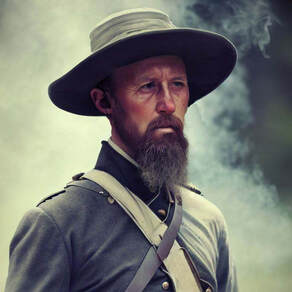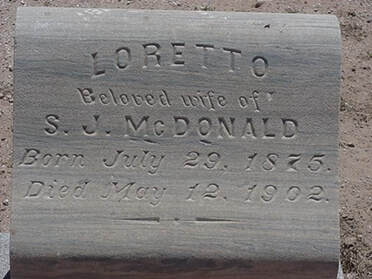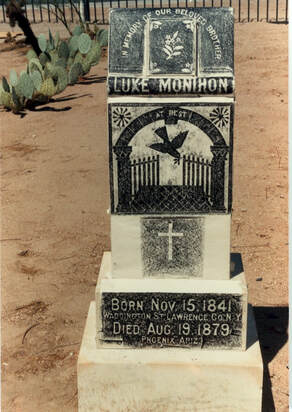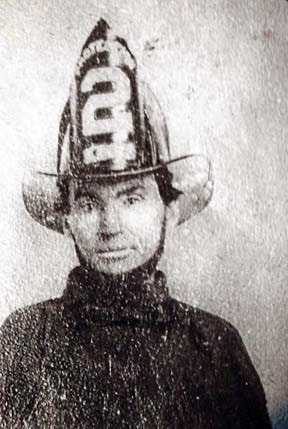 John D. Murphy About 1830-1897 Veteran of the Civil War Buried in Cementerio Lindo, exact location unknown (Image of a Civil War soldier, generated by Bing AI) John David Murphy was a Roman Catholic of Irish descent. Records imply that he was known throughout his life as John D, John David, or Jerry.
In April 1853, John married Sarah C. Jacobus. It was a ‘runaway marriage’ or elopement, so the young couple married in Essex County, New Jersey, where they were not known. The Murphys had five children: Jane, Sarah Elizabeth, Mary, Jerome Franklin, and Loretta. The federal census of 1860 recorded the Murphys living in Orange, Essex County, New Jersey, where John was working as a carpenter. The family seems to have been quite poor. Notwithstanding his age, John D. Murphy volunteered to fight in the Civil War. He enlisted on May 23, 1861, and was assigned to Company F, 72nd New York Infantry. His unit fought in the Peninsular Campaign, and Murphy was reported as wounded at the Battle of Williamsburg on February 5, 1862. After the war, Murphy was unable to work and, by 1880, he was no longer with his family. Family members say that he had developed a mania for wandering around the country. He lived for a time at the Old Soldiers Home in Dayton, Ohio, before heading out for Arizona. Around July 1, 1897, Murphy was living in a boarding house in Phoenix when he fell ill. His landlord cared for him for four days before sending him to the County Hospital. Murphy died there on July 10, 1897, and was buried in the Salt River Cemetery. Upon Murphy’s death, $600 in cash was found among his belongings, as well as letters from his daughter, Mary Murphy Hilliard. When the administrator of Murphy’s estate notified Mary of her father’s demise, he was surprised to learn that Murphy had a wife back in New Jersey. However, she was illiterate and depended on Mary to keep in touch with Murphy. After Mr. Murphy’s final expenses were deducted, his widow Sarah received what was left--$486. She was still living in 1910, when she was recorded on the federal census as residing on a farm in Montana, with her son Franklin and his wife. © 2023 by Donna L. Carr. Last revised 24 September 2023. If you would like assistance researching our interred, you can find more information on our website. You can contact us at [email protected] at any time. Thank you for your interest to preserve the history of Arizona's pioneers!
0 Comments
 Loretta Mary Huntington McDonald 1875-1902 Teacher Buried in Rosedale Cemetery North (Grave marker photo courtesy of the Pioneers’ Cemetery Association) Loretta was born in Halleck, Elko County, Nevada on July 29, 1875 to Cornelius Edson Huntington and Sarah nee O’Connor. At the time of her birth, her father was a soldier in the U.S. Army’s 12th Infantry, Company H, stationed at Camp Halleck. Camp Halleck had been established to protect the California Trail and construction workers of the Central Pacific Railroad. Shortly after Loretta’s birth, he was promoted to commissary sergeant.
Sgt. Huntington was reassigned to Camp Independence in Inyo County, California in 1876. Thereafter, the family remained in California while Loretta’s father was transferred from post to post. By 1880, they were living in San Diego, and three additional children had been added to the household: Edson (born 1876 in Nevada), Daniel (born 1878 in California), and Adele (born November 1879 in California). Another son, Paul, was born in 1883. After Huntington’s discharge from the military, he worked as a bookkeeper in San Pedro, California. This is where he died on August 24, 1893.* Loretta and the rest of the family had moved to Phoenix, Arizona, between 1880 and 1890, where Loretta entered college to become a teacher. Newspapers describe a young lady who enjoyed her friends and traveling to Prescott during the summer with her sister Adele. Loretta taught school for several years before marrying Samuel John McDonald, a stockman, on August 27, 1900. However, the couple had no children and Loretta was eventually diagnosed with tuberculosis. By 1901, her health had begun a steady decline. She died May 12, 1902, surrounded by her family, and was buried in Rosedale Cemetery. Her husband Samuel remained in Phoenix, unmarried, until about 1909, when he left for parts unknown. Both Loretta’s sister, Adele Walters, and brother, Paul Huntington, also succumbed to tuberculosis and appear to be buried near her in Rosedale Cemetery. *There is a discrepancy regarding when Cornelius died. His wife Sarah applied for a widow’s pension in August 16, 1890, while in Arizona, but the death record in California clearly shows that his name was not added to the register page until 1893. © 2020 by Patricia Gault. Last revised March 2020. If you would like assistance researching our interred, you can find more information on our website. You can contact us at [email protected] at any time. Thank you for your interest to preserve the history of Arizona's pioneers!  Luke Monihon 1841-1879 A Rancher Murdered Buried in City Loosley Cemetery, Block 2, Lot 6, north half (Grave marker photo courtesy of Pioneers’ Cemetery Association, Inc.) Luke Monihon was born on November 15, 1841, in Waddington, St. Lawrence County, New York. He was the son of James Monaghan and Ann Martin, immigrants from Ireland who had arrived in the United States between 1833 and 1837. The Monaghans were farmers.
James Davidson Monihon, Luke’s older brother, caught ‘gold fever’ in 1854 and went off to California to become a placer miner. In 1860, Luke was working as a hired hand for a Rutherford family, also in St. Lawrence County. No evidence has been found that Luke himself served during the Civil War, although his brother James enlisted in Company F, 1st California Infantry, which brought him to Arizona in 1863. Evidently James saw potential in the Salt River Valley and invited his brothers to join him. Of Luke’s and James’s siblings, Joseph and Christopher also came to Arizona. While their kin back in New York continued to spell their surname as Monaghan, the brothers in Arizona were known as Monahans, Monahons and, finally--Monihons. Luke Monihon was in Arizona by at least August 1875, when he filed on a homestead near his brother James’s, in the new Phoenix township. After “proving up," he received his homestead patent in May 1878. He married Sarah Elizabeth Wilcoxen, daughter of his neighbor Andrew Jackson Willcoxen, although the marriage appears to have been of short duration and there were no children. Sarah had been married previously and had a son by her first husband. On August 19, 1879, Monihon was driving home with a load of wood when he was shot in the back by an assailant who had been lying in wait along the road. The team of horses continued home where a ranch hand, seeing no driver, backtracked and found Monihon’s body. The following morning, deputy sheriffs Blankenship and Garfias picked up the trail of a man on foot near the site of the murder. A Maricopa Indian tracker followed the trail to the ranch of Monihon’s father-in-law, A. J. Willcoxen. The boot track was found to match that of John Keller, one of Willcoxen’s ranch hands who had reportedly been infatuated with Luke’s wife Sarah. The deputies arrested Keller but he was lynched by an angry mob a few days later. Monihon was originally buried in in the first Phoenix cemetery, but his grave was relocated to Loosley Cemetery after it opened in 1884. Monihon’s widow Sarah sold his ranch shortly thereafter, and the entire Willcoxen family moved to Ventura, California, to escape local opprobrium. © 2024 by Donna L. Carr. Last revised 27 February 2024. If you would like assistance researching our interred, you can find more information on our website. You can contact us at [email protected] at any time. Thank you for your interest to preserve the history of Arizona's pioneers!  Dennis Flynn About 1849-1906 Miner Buried in Porter Cemetery, Block 47, Space E (Grave marker photo courtesy of the Pioneers’ Cemetery Association, Inc.) Dennis Flynn was born about 1849 in Ireland. He came from Ireland to Boston at a young age, and an uncle provided for his schooling. He was in Virginia City, Nevada, during the height of the Comstock Lode in the 1870s. From there, he moved to Austin, Nevada, and Grass Valley, California. His name being a common one, it has not been possible to document his movements before he arrived in Arizona.
After moving to Arizona, he resided mostly in Yavapai County. He was a construction foreman on the Walnut Grove Dam at some point between 1886 and 1890. From about 1898 on, Flynn lived in Yarnell. The 1900 census recorded Flynn living in a boarding house in Wagoner, Yavapai County. He was single, said he came to the United States in June 1884 (perhaps he meant Arizona?), and was not a citizen, although he had registered to vote in Arizona from 1892 on. In 1900, he was a foreman at the Crown Point mine owned by Alexander Brodie. Flynn was a miner for about 25 years, although he apparently supplemented that income with other jobs. In 1905, he was road overseer for the county road from Kirkland to Congress and Octave. Somewhere along the way, Flynn contracted tuberculosis and his health began to fail. Seeking a warmer environment, he came from Peeples Valley to Phoenix on December 7, 1906, and took lodgings at the Commercial Hotel. Scarcely a day later, he was stricken unexpectedly and taken to Sisters hospital by his friend Ross Moore. That hospital being full, he was taken to the County hospital, where he died on December 9th. Another friend, Leopold Wallrath, arranged the funeral. Flynn’s obituary describes him as being of a pleasant and kind-hearted disposition who would be missed by those who knew him. He had no known relatives in this part of the country. Flynn was buried with a fine granite marker in Porter, Block 47, Space E. Although he was believed to have owned several mining claims, no probate has been found. © 2023 by Donna L. Carr. Last revised 30 December 2023. If you would like assistance researching our interred, you can find more information on our website. You can contact us at [email protected] at any time. Thank you for your interest to preserve the history of Arizona's pioneers!  Christopher Baine About 1832-1899 Carpenter and Firefighter Buried in City Loosley Cemetery, exact location unknown (photos courtesy of Baine descendants via Tim Kovacs) Christopher Baine was born about 1832 in Dublin, Ireland—possibly to Lawrence and Ellen Bain. It is not known when he immigrated to the United States but, by 1860, he was living in Sacramento, California, and working as a wheelwright and wagon-maker. Several newspaper articles attest to the fact that, while living in Sacramento, Baine was a member of the city’s fire department. He served in Engine Company #2.
Baine was in Arizona City (now Yuma), Arizona, in 1868, when he married Jesus Dominguez Esquer, born 1844. At the time of the marriage, Jesus Dominguez already had a little daughter named Maria Cruz by her previous relationship with Donaciano Cruz. With Baine, she had a daughter Guadalupe, born 1869; a daughter Emilia, born 1871; a son Thomas/Tomás, born in 1873; a daughter Sarah, born in 1875; and a daughter Juanita, born in 1879. Baine seems to have been well-respected while living in Yuma. He worked as a carpenter and served for a time as coroner and school trustee. He also owned a store on the corner of Main Street, Maiden Lane, and Second Street, which he rented to Isaac Lyons. The Baine family’s life in Yuma was thrown into turmoil on July 29, 1879, when Baine shot and killed his brother-in-law, Antonio Ruiz, who was married to Jesus’s sister. At about 1 AM, Ruiz, drunk, appeared at the Baines’ house, from which he had been ejected a month before. When told to leave, he did, but returned a few hours later. Baine, fearing that Ruiz had come back with a gun, again ordered him to leave. When Ruiz advanced instead, Baine fired four times. Ruiz died several hours later. Baine immediately turned himself in to the sheriff. The grand jury set his bail at $1000. It does not appear, however, that Baine was charged with anything beyond defending his home from an intruder. As time went on, the Baines had two more children: a son Angel, born 1882, and a son Jose, born 1888. Newspaper articles describe Baine as working as a carpenter, joiner, and cabinet-maker between 1880 and 1895, although somewhat hampered by neuralgia. By 1884, the Baine family had relocated to Phoenix. On January 23, 1899, Christopher Baine died of typhoid fever and was buried in City/Loosley Cemetery. So thoroughly was Baine identified with the Mexican community, that an El Paso newspaper described him as “one of the best known and most respected Mexicans of Maricopa County”. Although the exact location of his grave is no longer known, Baine has a cenotaph brick in the Pioneer & Military Memorial Park’s memorial garden. © 2023 by Donna L. Carr. Last revised June 15, 2023. If you would like assistance researching our interred, you can find more information on our website. You can contact us at [email protected] at any time. Thank you for your interest to preserve the history of Arizona's pioneers! |